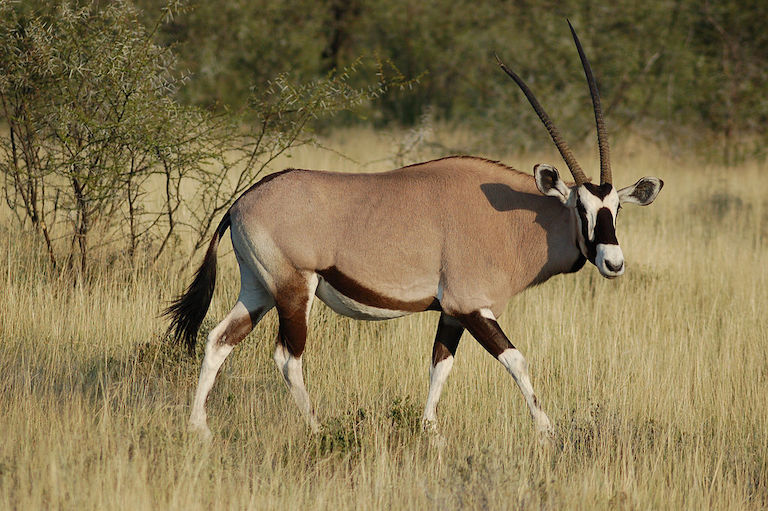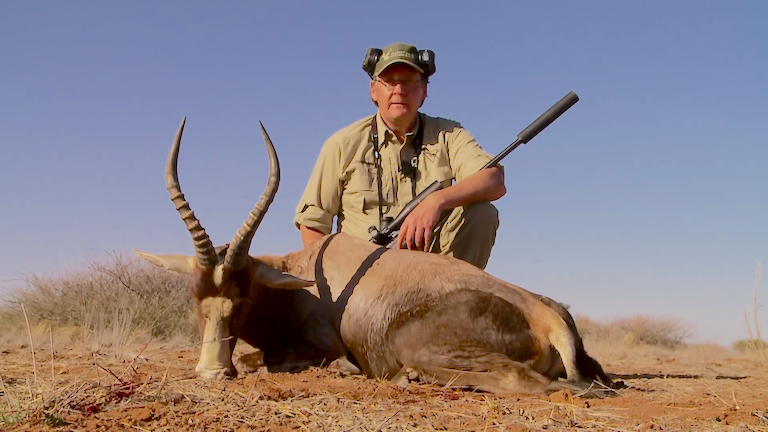- Namibia is often cited as a case study to make arguments for trophy hunting, a morally contentious practice that has been adapted into a conservation strategy there by various stakeholders including community-based conservancies.
- But a 2016 study of the total revenue generated by trophy hunting revealed that 92% went to ‘freehold’ landowners, over 70% of whom are white, while less than 8% went to communal conservancies.
- If we are sincere about aligning environmental and social justice, then centering trophy hunting related debates in Namibia around racial inequalities would be an essential and meaningful step, a new op-ed argues.
- This article is a commentary. The views expressed are those of the author, not necessarily of Mongabay.
With the relatively recent proposal in the British parliament to ban the import of wildlife trophies, the issue has once again taken center stage among factions of the global conservation community. Despite the potential ban’s limited impact on its own trophy hunting industry, Namibia is often raised as a case study to make a strong argument for a morally contentious practice that has been adapted into a conservation strategy.
Most of Namibia’s hunting clients are either EU or US citizens, making a ban in the UK no immediate threat. Data from 2016 suggest that only 4% of Namibia’s hunting clients are even likely to be British. However, as other African conservation sectors stand to lose valuable clientele, fears over a hugely impactful precedent have put Namibia’s conservation and hunting fraternities on high alert as well.
Fears arise from revenue generated through trophy hunting being diminished by a blanket ban; revenue often earmarked for conservation and in Namibia’s case, rural poverty alleviation. While not untrue, this framing neglects some socio-political history, which is still playing itself out today.

The country’s conservancy-based conservation model has distinguished itself by conferring rights to wildlife resource use to communally-run conservancies. This was enacted through a legislative amendment back in 1996, after Namibia gained independence from South Africa in 1990. Before that, rights to wildlife resources were reserved for commercial or freehold landowners exclusively, who – based on apartheid’s racialized politics – were of European descent.
This extension of rights has gained plaudits from conservation actors across the globe. Once a communally driven conservancy is formally registered, it is granted ownership of wildlife, and with it, access to previously inaccessible revenue streams. Through value addition, it is also meant to incentivize conservancies to manage their wildlife resources in a sustainable manner (e.g. through ecotourism or trophy hunting); especially, given that many of them overlap with the ranges of species with high conservation value.
Areas in which relatively high densities of human and wildlife populations coincide provide stern challenges for conflict-free coexistence – challenges, at least partly, mitigated by financial assistance. The most recent State of Community Conservation in Namibia Report declared that the country now boasts 86 registered conservancies, covering over 166,000 km2. As part of this revised governance structure, conservancies are entitled to allocate a count-derived quota of game to trophy hunting, the proceeds of which are meant to feed the conservancy coffers, in an attempt to bolster resident livelihoods.
Socio-economic benefits to marginalized rural communities are often presented as a lead argument for trophy hunting’s retention as a conservation tool, with little to no further analysis. As far as rural livelihoods and trophy hunting go, though, conservancies are comparatively diminutive beneficiaries of an industry that thrives on Namibia’s commercial farmland – control over which has largely been spared corrective de-colonial measures. This is an aspect that is rarely accommodated in narratives mostly built around empowering communities on the margins of Namibian society.
In Namibia, land remains a hotly debated issue and epitomizes some of the lingering inequalities engineered by decades-long German and South African oppression. A report published by the Namibian Statistics Agency (NSA) in 2018 suggests that just over 70% of all freehold land remains white-owned – a demographic comprising less than 10% of Namibia’s population. This inequality was also, perhaps coincidentally, captured in a survey-based publication looking to highlight the benefits of wildlife-based land uses on privately owned land in Namibia. Four respondents were randomly sampled from each of 60 of the 81 associations affiliated with the Namibian Agricultural Union at the time – more than 87% of those respondents were white.

The NSA also reports that commercial agricultural land constitutes the largest land tenure system in the country, spanning a cumulative area of close to 398,000 km2, which amounts to almost 50% of Namibia’s territory. Government attempts to return land to communities it was expropriated from have been inconsistent, and a far cry from anything resembling restorative justice.
Following its inaugural event back in 1991, the Namibian government convened the second National Land Conference in 2018 to try and reinvigorate land reform efforts, which despite legislative adjustments, had been underwhelming. And little indication has been offered to suggest that that trend is likely to be bucked – since the 2018 conference, only 29 of the proposed 167 resolutions have been fulfilled – with further progress seemingly in limbo.
A recent assessment of the Southern African Customs Union by the World Bank stressed that Namibia is among the most unequal countries in the world, based on a set of welfare indicators. Apropos though, “historically high inequality of land ownership” was outlined as one of the key drivers of socio-economic disparity in Namibia and South Africa.
Currently, about a quarter of commercial farmland is being utilized for trophy hunting enterprises. A study commissioned by Namibia’s Ministry of Environment, Forestry and Tourism, and the Deutsche Gesellschaft für Internationale Zusammenarbeit GmbH (a German NGO) found that in 2016, of the total revenue generated by trophy hunting in Namibia, 92% was attributed to freehold land – less than 8% to communal conservancies. Commercial farms also outcompeted communal conservancies in terms of other hunting-related expenditures received, such as those for taxidermy or transportation services rendered. This juxtaposition is even further compounded when we consider that communal land supports considerably higher human population densities than freehold land. In fact, almost two-thirds of privately owned land is registered to individuals.
Beyond land ownership, settler control over Namibia’s trophy hunting industry is further typified by the fact that in 2013, one out of 555 hunting operators was non-white, and institutionalized by organizations such as the Namibian Professional Hunting Association, which is entirely white-run.
Conservation has not always frequented the vernacular of Namibia’s trophy hunting fraternity and white land ownership at large. Today though, it serves as an effective, albeit fragile argument for the maintenance of contemporary land tenure dynamics. When presented, these arguments are often littered with racist undertones, carrying the insinuation that conservation efforts would suffer in the wake of just land reform.
See related: UK trophy hunting import ban not supported by rural Africans

Racial tensions still permeate Namibian society, with racial abuse characteristic of white owned farms, in particular. Former and founding Namibian President Sam Nujoma has been among a range of prominent figures to publicly address this issue. Namibia’s non-managerial labor on white-owned land is overwhelmingly, if not exclusively, Black and enjoys very little, if any, substantive protection from racialized forms of abuse – in a country, no less, where racial discrimination qualifies as a criminal offense.
A group of researchers from the University of Kent have illustrated racism’s implications for human-wildlife conflict on settler-owned Namibian farms. Their study also revealed how common racially motivated mistreatment of farm workers by farmers is, something I can only attest to, based on lived experiences. It also serves as an important testimony of overtly colonial labor relations and demonstrates how this, and multilevel socio-economic discrepancies exacerbate environmental challenges.
Due to its nature and relative ubiquity, trophy hunting attracts a variety of opinions and voices. In Namibia, and Africa at large, the debate has been peppered with loud and plentiful non-Namibian contributions – on either side of the pro-con spectrum. Often extending criticism to Namibia’s conservancy-based model as a whole – something the executive director of the Integrated Rural Development and Nature Conservation recently bemoaned. His frustrations are understandable, given that the livelihoods of marginalized communities are often treated as mere collateral damage by people far removed from any Namibian realities. While a community-based approach is commendable and should be encouraged, within Namibian conservation a more critical view of the structural violence enacted by private land tenure is overdue. And it should be even more telling, if the consensus is that the latter undermines the former. Unfortunately, we find ourselves in a position where conservation is essentially used as a safeguard for colonial-era structures.
Government’s responsibility, or shirking thereof, should also not be discounted, given Namibia’s rampant poverty and elevated unemployment rates. If basic services were adequately delivered, there would be no need to rely on socially debilitating structures to supplement rural livelihoods and environmental protection efforts. However, with the parliament’s most recent budgetary allotments, hope for that is in short supply.
With large shares of the national budget reserved for the military and policing, labor researcher Herbert Jauch has emphasized that the budget reflects government’s preference to deal with the security-related fallout from social issues, rather than with the issues themselves. And this applies to environmental issues too. Additionally, Namibia’s status as an upper middle-income country prevents it from accessing more developmental funds, including those designated for biodiversity conservation. Namibian President Hage Geingob has previously expressed his frustrations regarding this classification, which is partly a result of the scale of inequality in the country.
See related: Can we plan for a future without trophy hunting?

If Namibia’s conservation sector insists on driving an equality-based narrative around trophy hunting, then skirting the land issue seems hypocritical at best. In an era where the term “decolonization” is afforded more and more space in conservation, the concept remains ambiguous to many. Namibian conservation’s de- or anti-colonial challenge, however, presents an incredibly tangible case study. Ongoing racialized inequality is a glaring omission from Namibia’s community-based conservation success story.
If we are sincere about aligning environmental and social justice, then centering trophy hunting related debates in Namibia around prevailing inequalities would be an essential and meaningful step. It should function as an incentive to accelerate the development of not just alternative funding mechanisms, but governing structures. It also presents an opportunity, should the need arise, to help prepare the trophy hunting industry for life after land reform.
Questions remain, of course, over whether trophy hunting will retain its appeal in Namibia without the colonial experience currently on offer. While facilitating land redistribution might fall outside of conservation’s mandate, actively participating in the national discourse could go a long way. Critique of freehold land’s role in Namibia’s trophy hunting complex should thus not be construed as an attack on community conservation, but as a call for greater solidarity in a genuine pursuit of socio-environmental justice.
Frowin Becker is a Namibian conservation scientist and doctoral candidate at the Victoria University of Wellington/Te Herenga Waka, New Zealand.
Related audio from Mongabay’s podcast: Maxi Pia Louis directs a Namibian organization that works with local communities to support conservation and discusses their supportive stance on trophy hunting, listen here: